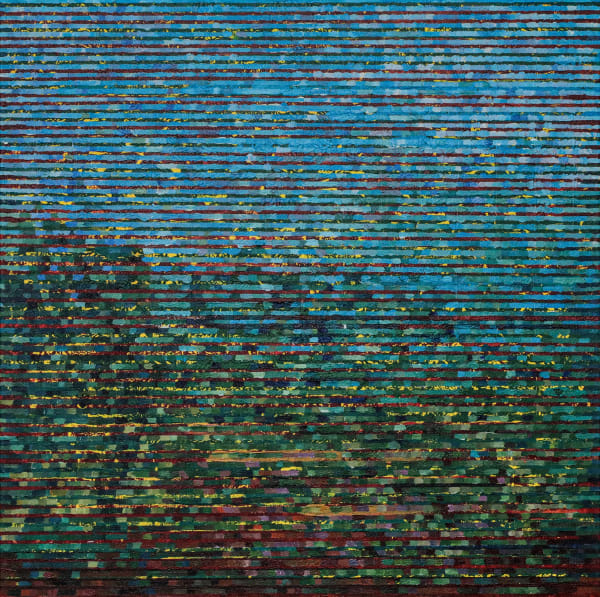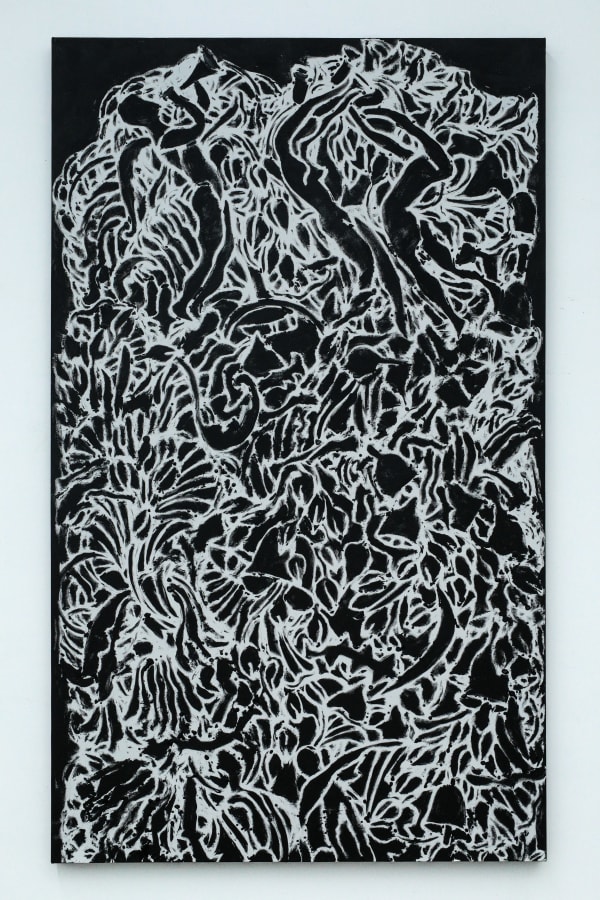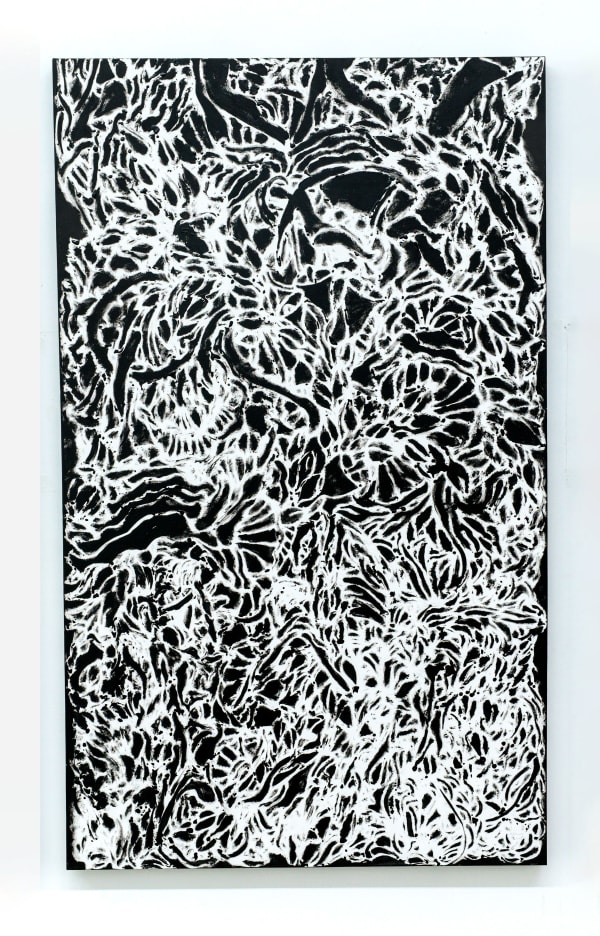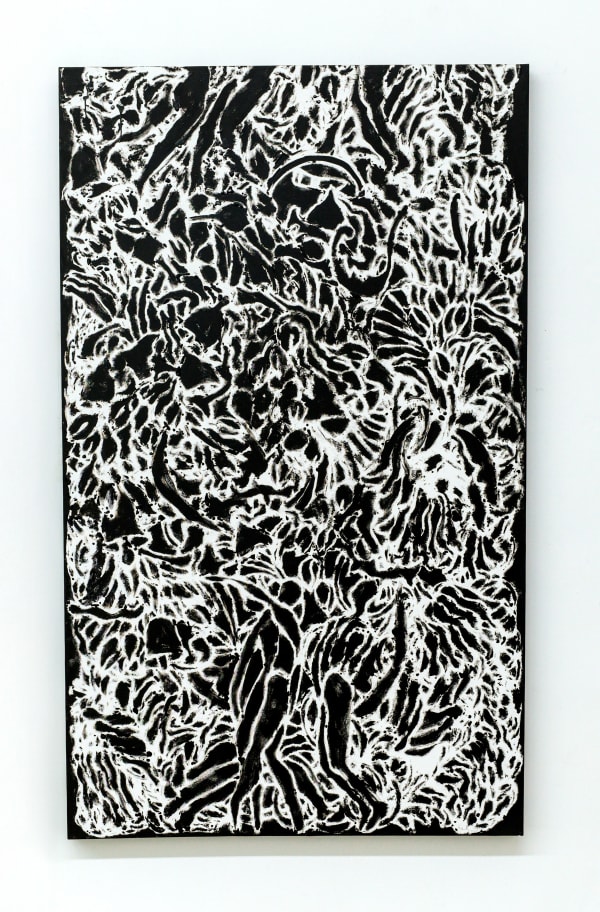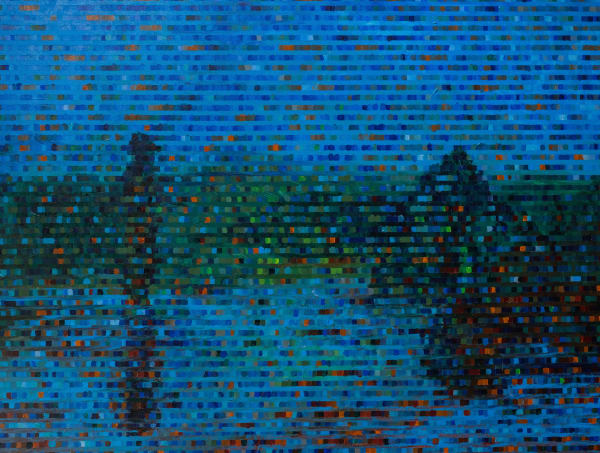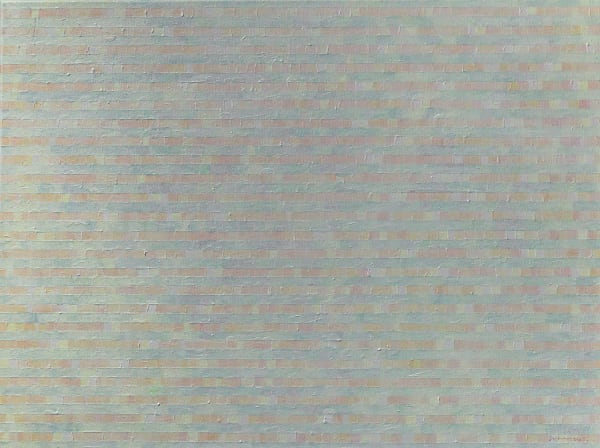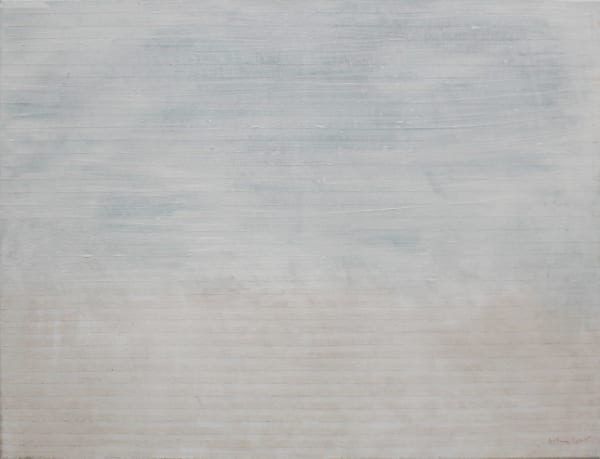Neo-Glitch: Chandraguptha Thenuwara
The title "Neo-Glitch" is derived from the term "glitch," which refers to a sudden, temporary malfunction commonly observed in TV screens. This idea serves as a metaphor for the interruptions and disruptions in governance that have plagued a nation grappling with its identity amidst economic strife and conflicting ideologies. The ‘Glitch’ series began in 2016, following the "Good Governance” regime and the ousting of two long-standing governments amid three decades of ethnic conflict. In 2022, a new regime was overthrown by popular struggle due to economic mismanagement, prompting experienced politicians to implement unpopular recovery measures. During the recent elections, the populace rejected these measures in favor of 'socialistic' views over neo-liberal politics.
The arrival of the new government has brought socialism back into the discussion. However, the economically struggling country has not yet fully recovered. The unexpected election results granted the new president an over two-thirds majority, yet the political environment remains uncertain, filled with hopes and promises. Can the leaders meet the people's ambitions quickly? Questions arise about the rapid transformation toward a socialist ideal, leading to the emergence of "Neo-Glitch," signaling the start of a new series.
What do we see? An unclear picture is the result of this political change. The leaders promised to achieve what was possible and even impossible to gain power. They continuously made unfounded accusations against their opponents, undermining the people's confidence and persuading them to accept any concessions. They convinced the majority that challenges requiring collective action could not be addressed collaboratively, while confirming they had a stable support base among the populace. While the use of televised drone camera shots hypnotized news followers.
In the three-dimensional iron rods structure, numerous symbolic elements reflect society over the last few decades and remain unchanged today. Bells and lotus buds intertwine and spread throughout the screen, depicting the new reality. Other symbolic representations include racism, extreme religiosity, patriotism, thuggish violence, endless killings, and buried mass graves. Yet, amidst all these, patterns create a sense of beauty that attracts viewers and enhances their experience. Drummers, musicians, and dancers enjoy themselves, momentarily forgetting their surroundings, which is depicted in the symbolic backgrounds. Some dancing figures fade away amidst the overall patterns.
The majority of the paintings represent unstable landscapes. They form a collection showcasing various neo-glitch situations. They are not abstract but depict the current political landscape and the events happening around us now. History continues to repeat itself. Unresolved post-pogrom and post-war issues, coupled with broken political and economic promises, blur our vision. Therefore, these paintings emerge at this time, labelled as 'Neo-Glitch.' Among them are blurred landscapes, land from which escape is impossible, unclear and destroyed landscapes, and charred earth reduced to ashes. The rhetorical question posed by graffiti “Are you happy now?”(This is the second version) serves as a haunting inquiry into the promises made by leaders, now veiled by disappointment. Some of the 'conceptually realistic' works depict unacceptance /negation. 'This is not a container; this is not white; this is not Black, and so on.
Images that once became clearer have gradually turned unclear again. The Promised Land approaches disappointment, and difficulties increase day by day. There is no search for, or accountability for, the missing. Discussions about women's rights to control their bodies and sexual labour seem non-existent. Lies prevail, and blame is shifted to others. Where is the promised 'system-change'?
Ultimately, “Neo-Glitch” serves as a call to awareness and accountability. It challenges both the leaders and the citizens to confront the realities of their socio-political existence and engage in a meaningful dialogue about change. The grand promise of peace and unity hangs in the balance, requiring not just identified leadership but an engaged populace willing to question, reflect, and demand genuine accountability. In this intricate dance of hope and despair, the future remains uncertain, but the need for transformation is as urgent as ever.
-
 Chandraguptha ThenuwaraNeo Glitch: Landscape I, 2025Acrylic on Canvas90 x 90 cm
Chandraguptha ThenuwaraNeo Glitch: Landscape I, 2025Acrylic on Canvas90 x 90 cm
35 3/8 x 35 3/8 in -
 Chandraguptha ThenuwaraScreen V, 2025Acrylic on Canvas153 x 91 cm
Chandraguptha ThenuwaraScreen V, 2025Acrylic on Canvas153 x 91 cm
60 1/4 x 35 7/8 in -
 Chandraguptha ThenuwaraScreen III, 2025Acrylic on Canvas153 x 91 cm
Chandraguptha ThenuwaraScreen III, 2025Acrylic on Canvas153 x 91 cm
60 1/4 x 35 7/8 in -
 Chandraguptha ThenuwaraScreen IV, 2025Acrylic on Canvas153 x 91 cm
Chandraguptha ThenuwaraScreen IV, 2025Acrylic on Canvas153 x 91 cm
60 1/4 x 35 7/8 in
-
 Chandraguptha ThenuwaraNeo Glitch: Landscape II, 2025Acrylic on Canvas70 x 92 cm
Chandraguptha ThenuwaraNeo Glitch: Landscape II, 2025Acrylic on Canvas70 x 92 cm
27 1/2 x 36 1/4 in -
 Chandraguptha ThenuwaraNeo Glitch: Wasteland, 2025Acrylic on Canvas123 x 153 cm
Chandraguptha ThenuwaraNeo Glitch: Wasteland, 2025Acrylic on Canvas123 x 153 cm
48 3/8 x 60 1/4 in -
 Chandraguptha ThenuwaraNeo Glitch: Inescapable Landscape, 2025Acrylic on Canvas153 x 244 cm
Chandraguptha ThenuwaraNeo Glitch: Inescapable Landscape, 2025Acrylic on Canvas153 x 244 cm
96 x 60 1/4 in -
 Chandraguptha ThenuwaraAre You Happy Now? II, 2025Acrylic on Canvas133 x 209 cm
Chandraguptha ThenuwaraAre You Happy Now? II, 2025Acrylic on Canvas133 x 209 cm
52 3/8 x 82 1/4 in
-
 Chandraguptha ThenuwaraNeo Glitch: Landscape III, 2025Acrylic on Canvas92 x 122 cm
Chandraguptha ThenuwaraNeo Glitch: Landscape III, 2025Acrylic on Canvas92 x 122 cm
36 1/4 x 48 in -
 Chandraguptha ThenuwaraNeo Glitch: This is not White , 2025Acrylic on Canvas60 x 80 cm
Chandraguptha ThenuwaraNeo Glitch: This is not White , 2025Acrylic on Canvas60 x 80 cm
23 5/8 x 31 1/2 in -
 Chandraguptha ThenuwaraNeo Glitch: Erasing a Landscape, 2025Acrylic on Canvas46 x 61 cm
Chandraguptha ThenuwaraNeo Glitch: Erasing a Landscape, 2025Acrylic on Canvas46 x 61 cm
18 1/8 x 24 in -
 Chandraguptha ThenuwaraNeo Glitch: This is not Black, 2025Acrylic on Canvas60 x 80 cm
Chandraguptha ThenuwaraNeo Glitch: This is not Black, 2025Acrylic on Canvas60 x 80 cm
23 5/8 x 31 1/2 in

